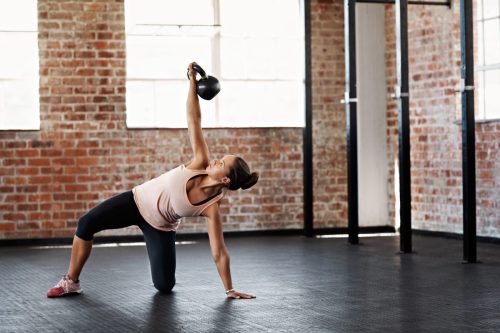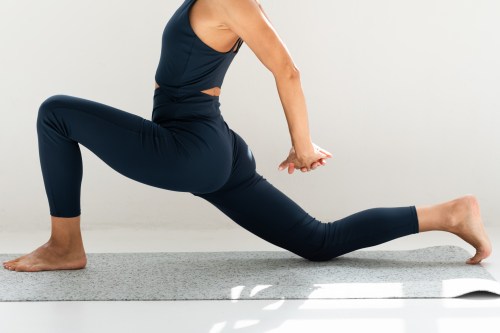The TL; DR of Turkish get ups is this: You begin lying on the floor with a kettlebell in one hand and end up standing with the bell thrust into the air above you in a that shouts “victory!” “They’re excellent for hip mobility, shoulder mobility, and shoulder strength,” says Maillard Howell, owner of Dean CrossFit and founder of The Beta Way. “You’re using your entire body to go from a lying position to standing tall with load overhead in one arm, so yeah, everything’s going to be firing. Everything’s going to be on. It’s a lot of core, it’s a lot of shoulder strength and shoulder mobility, hip strength, and hip mobility.”
Even more bang for your fitness buck: This move somewhat emulates the “sitting-rising test” (SRT)—a functional movement test developed by Brazilian physician Claudio Gil Araújo, MD, that’s an indicator of longevity. Only, the get ups are way harder. So if you master them, the SRT will be a breeze. So grab a kettlebell on the lighter side and let’s get started, shall we?
How to master Turkish get ups, according to a CrossFit trainer
To be completely honest with you, this move is better learned through a visual demonstration (like the one above). But in case you like to read your way to understanding exercises, here’s how to perform a get up on your right side.
1. Begin lying on the ground with the kettlebell clutched in your right hand. Hold it shoulder level. Keep your eyes on the kettlebell.
2. Place your right foot on the ground and thrust the kettlebell straight up into the air.
3. Place your left arm on the floor approximately 45 degrees from the bod.
4. Roll up onto your forearm, pause, then press through your fingertips to come up onto your left hand. The kettlebell is still thrust in the air. The other parts of your body haven’t changed.
5. Lift your hips off the ground, engaging your glutes.
6. Sweep your left leg under your body and place it behind the left hand. Both legs should be at 90 degree angles. The right knee will be pointing straight ahead; the left knee should point at the hand on the floor.
7. Remove your left hand from the ground so that your body is upright.
8. Pivot your left leg so that you’re in a low lunge position.
9. Shift the weight from your back foot forward so you can come to stand.
10. Ta-da! Oh, and now you do the whole thing in reverse. (Then, don’t forget to balance it out by switching side with the kettelebell!)
Looking for even more moves? Challenge yourself with this 6-step plank workout or the truly challenging Spiderman push-up.
Sign Up for Our Daily Newsletter
Get all the latest in wellness, trends, food, fitness, beauty, and more delivered right to your inbox.
Got it, you've been added to our email list.











